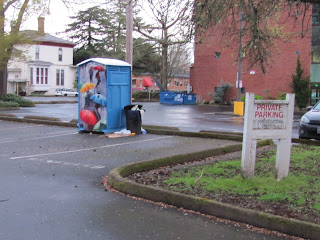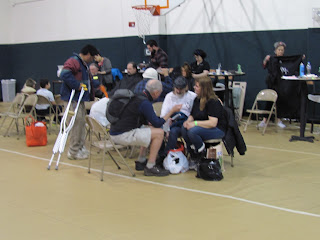By Sarah Rohrs
It’s a lot of work to be poor, even for just one hour.
That’s what many learned Thursday, March 17th, while taking part in a “poverty simulation” held at Salem First Presbyterian Church in the downtown area.
The hour-long simulation was designed to give participants a greater understanding and empathy for those who live in poverty and who struggle daily to make ends meet.
Social service agency representatives, many of whom help poor and needy people in their work, took advantage of the simulation to be reminded of the challenges those in poverty face.
Shane Olson of the HOME Youth & Resource Center in Salem took part in his first simulation and said he found it helpful.
Olson is familiar with homelessness, poverty and other struggles youth and families face in Salem and Marion County. But, he said it’s good for him and others to continually gain deeper awareness and empathy for the poor.
Transportation, child care issues and other factors could be barriers for a poor person that another might not find a hindrance at all.
And poverty is no small problem in Oregon. With statistics in hand, CoActive Connections, based in Salem, painted a troublesome economic picture. The nonprofit organization stages poverty simulations all over the state to raise awareness.
Oregon’s poverty rate is 17 percent, according to federal income guidelines that some consider outdated, said Melinda Gross, CoActive Connections executive director.
Using these guidelines, a family of four earning less than $24,250 is said to be in poverty. A family of four earning more than that is not in poverty.
Some 18 percent of the residents in Salem and Keizer live below the poverty line, and more than 20 percent of the area’s children are poor -- under these guidelines.
However, if more current housing and other costs are taken into consideration, nearly 38 percent of Oregonians are thought to be unable to meet all their basic needs, Gross said.
A more realistic annual income for a family of four is closer to $63,000, not $24,250, she said.
Of particular note about Oregon’s population in poverty is that adults in most poor families are working at least one job.
“Most Oregon households experiencing poverty have at least one person working, and research shows that people in lower incomes work just as much as people in higher incomes. They just don’t make enough money,” Gross said.
Though large in numbers, many poor people feel invisible, devalued or hidden in plain sight.
“A big part of (the simulation) is giving voice to people and their experiences and giving value to those experiences. There’s also an aim to improve policies and services so that they have better and improved services,” she said.
How is poverty simulated? CoActive Connections has developed a model to recreate situations poor families might find themselves in. The entire process takes 3 hours which includes a presentation on poverty, then an hour-long debriefing.
During the event, groups of four people form mock working class families facing any number of hardships those in poverty might face.
Those include low wages, lack of reliable transportation to get to work, obtaining child care, not leaving kids at home alone, health difficulties, plus random challenges, such home repairs or a child sent to juvenile hall.
Throughout the simulation, participants need to scramble to plan how to stretch their dollars, get to work on time, obtain social services and also deal with unexpected surprises, such as illegal evictions.
Their overall goal is to get through a month making ends meet and having a little left over.
“If it was real it would be very stressful,” said Elijah Jung, a little boy who participated in the simulation with his mother, Dayna Jung.
In the mock Xanthos family, Zelda and Anthony Xanthos have had custody of their young grandchildren for several months, following the incarceration of their mother.
Zelda, 50, works full time as a cashier, earning $9.50 an hour, and has little English. Her husband has no high school degree, is diabetic and gets $500 a month on disability
They have a monthly mortgage, utility bills, medical bills, a car payment, and must pay for transportation, clothing, food and other expenses.
During the simulation the Xanthos family had to work together to figure out how they could make it through the month.
Zelda is frequently late for work and has her pay docked. She is forced to cash her check at a
check cashing store and loses part of it in fees.
Meanwhile, Anthony goes to apply for food stamps and social services, but after waiting in a long line he was told he didn’t qualify at that time, and he should come back. During the event, the family got a “luck of the draw” card, namely a plumbing emergency.
Both grandparents got sent to “jail” because neither one was home when the kids got there from school.
The family ran out of money throughout the month, and had to
pawn a few items to pay their bills and keep food on the table.
During the group debriefing following the simulation many participants said it was hard to pay attention to all the things in their lives.
Some said they found they had no time to get to the store for food, or to spend any time with their kids.
Some of the adults playing children also said they felt abandoned as their parents or grandparents focused on working, making their appointments and going from one place to another.
Other “children “ felt like they had to grow up too fast and spend too much time and energy helping their parents get enough money for the household.
Christopher Hopp, of the
Options Family Counseling Services in Salem, played a school teacher. He said he felt bad that so many of the poor kids in the mock “classroom” were sent home with notes to the parents to pony up money for field trips, supplies and other items.
He knew the poor children would be unable to participate and he said it broke his heart. “I think schools put a lot of pressures on the parents,” he said.
Another participant said the simulation drove home a thought that the “poor have no voice of their own.” Another man said it felt like his mock family members were “victims of everything.”
“I was a victim because of the economic situation I was in. The wife and husband lost everything,” he said.
Some participants, however, said they were able to navigate the various social service stations to obtain job training, housing and food vouchers and other items which allowed them to improve their economic situations.
Olson and his family were able to do that because of his knowledge of the system in his job.
Others in pointed out that lack of knowledge of resources and where to go could present an enormous obstacles and lost opportunities to find better jobs and more income.
Meanwhile, Gross and Lori Beamer, CoActive Director of Operations and Outreach, said the stigma and stress of living in poverty are enormous barriers.
Some studies show that those in severe poverty actually lose IQ points because they devote so much of their time and energy to figuring out how to survive, Gross said.
Beamer said once their economic status improves the IQ points start to go back up to their pre-poverty levels.
As someone who grew up in poverty herself, Gross said a primary goal of the simulation is to encourage people not to think of poor folks as “others.”
“I think the most important piece (of the simulation) is something that’s attached to our vision statement and that is nobody will be treated differently due to their economic status,” Gross said.
“We’re all people who have our own individual experiences and we need to value each person’s worth regardless of how much they earn. That is really important,” she said.




































